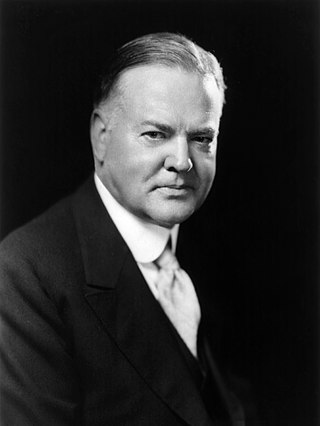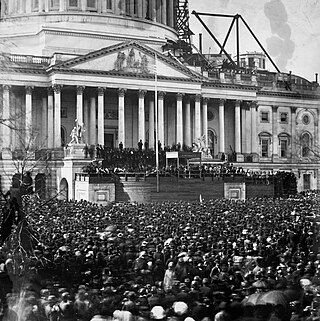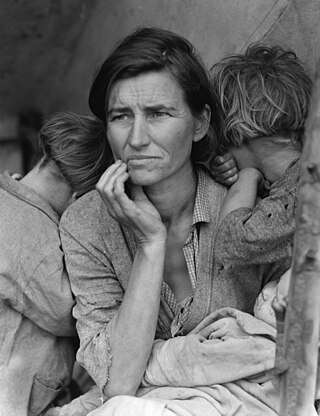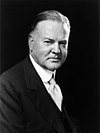
The Four Freedoms were goals articulated by U.S. President Franklin D. Roosevelt on Monday, January 6, 1941. In an address known as the Four Freedoms speech, he proposed four fundamental freedoms that people "everywhere in the world" ought to enjoy:
- Freedom of speech
- Freedom of worship
- Freedom from want
- Freedom from fear

The State of the Union Address is an annual message delivered by the president of the United States to a joint session of the United States Congress near the beginning of most calendar years on the current condition of the nation. The State of the Union Address generally includes reports on the nation's budget, economy, news, agenda, progress, achievements and the president's priorities and legislative proposals.

The Wall Street Crash of 1929, also known as the Great Crash or the Crash of '29, was a major American stock market crash that occurred in the autumn of 1929. It began in September, when share prices on the New York Stock Exchange (NYSE) collapsed, and ended in mid-November. The pivotal role of the 1920s' high-flying bull market and the subsequent catastrophic collapse of the NYSE in late 1929 is often highlighted in explanations of the causes of the worldwide Great Depression.

The 1930 United States House of Representatives elections were elections for the United States House of Representatives to elect members to serve in the 72nd United States Congress. They were held for the most part on November 4, 1930, while Maine held theirs on September 8. They occurred in the middle of President Herbert Hoover's term.

The Second Bill of Rights or Bill of Economic Rights was proposed by United States President Franklin D. Roosevelt during his State of the Union Address on Tuesday, January 11, 1944. In his address, Roosevelt suggested that the nation had come to recognise and should now implement, a second "bill of rights". Roosevelt argued that the "political rights" guaranteed by the Constitution and the Bill of Rights had "proved inadequate to assure us equality in the pursuit of happiness". His remedy was to declare an "economic bill of rights" to guarantee these specific rights:

American Regionalism is an American realist modern art movement that included paintings, murals, lithographs, and illustrations depicting realistic scenes of rural and small-town America primarily in the Midwest. It arose in the 1930s as a response to the Great Depression, and ended in the 1940s due to the end of World War II and a lack of development within the movement. It reached its height of popularity from 1930 to 1935, as it was widely appreciated for its reassuring images of the American heartland during the Great Depression. Despite major stylistic differences between specific artists, Regionalist art in general was in a relatively conservative and traditionalist style that appealed to popular American sensibilities, while strictly opposing the perceived domination of French art.

The 2005 State of the Union Address was given by the 43rd president of the United States, George W. Bush, on February 2, 2005, at 9:00 p.m. EST, in the chamber of the United States House of Representatives to the 109th United States Congress. It was Bush's fourth State of the Union Address and his fifth speech to a joint session of the United States Congress. Presiding over this joint session was the House speaker, Dennis Hastert, accompanied by Dick Cheney, the vice president, in his capacity as the president of the Senate.

Herbert Hoover's tenure as the 31st president of the United States began on his inauguration on March 4, 1929, and ended on March 4, 1933. Hoover, a Republican, took office after a landslide victory in the 1928 presidential election over Democrat Al Smith of New York. His presidency ended following his defeat in the 1932 presidential election by Democrat Franklin D. Roosevelt.

Abraham Lincoln's first inaugural address was delivered on Monday, March 4, 1861, as part of his taking of the oath of office for his first term as the sixteenth president of the United States. The speech, delivered at the United States Capitol, was primarily addressed to the people of the South and was intended to succinctly state Lincoln's intended policies and desires toward that section, where seven states had seceded from the Union and formed the Confederate States of America.

The Great Depression (1929–1939) was a severe global economic downturn that affected many countries across the world. It became evident after a sharp decline in stock prices in the United States, leading to a period of economic depression. The economic contagion began around September 1929 and led to the Wall Street stock market crash of 24 October. This crisis marked the start of a prolonged period of economic hardship characterized by high unemployment rates and widespread business failures.

The first inauguration of Franklin D. Roosevelt as the 32nd president of the United States was held on Saturday, March 4, 1933, at the East Portico of the United States Capitol in Washington, D.C. This was the 37th inauguration, and marked the commencement of the first term of Franklin D. Roosevelt as president and John Nance Garner as vice president.

Barack Obama served as the 44th President of the United States from 2009 to 2017. Before his presidency, he served in the Illinois Senate (1997–2004) and the United States Senate (2005–2008).
The 1816 State of the Union Address was the last annual address given by President James Madison, the fourth president of the United States.
The 1934 State of the Union Address was given on Wednesday, January 3, 1934, by the 32nd president of the United States, Franklin D. Roosevelt. It was the first State of the Union address to be given in January since George Washington's first State of the Union Address in 1790.
The 1901 State of the Union Address was given on Tuesday, December 3, 1901, by the 26th president of the United States, Theodore Roosevelt. It was presented to both houses of the 57th United States Congress, but he was not present. He stated, "The Congress assembles this year under the shadow of a great calamity. On the sixth of September, President McKinley was shot by an anarchist while attending the Pan-American Exposition at Buffalo, and died in that city on the fourteenth of that month." He concluded it with, "Indeed, from every quarter of the civilized world we received, at the time of the President's death, assurances of such grief and regard as to touch the hearts of our people. In the midst of our affliction we reverently thank the Almighty that we are at peace with the nations of mankind; and we firmly intend that our policy shall be such as to continue unbroken these international relations of mutual respect and good will."
The 1974 State of the Union Address was given to the 93rd United States Congress, on Wednesday, January 30, 1974, by Richard Nixon, the 37th president of the United States. He said, "We meet here tonight at a time of great challenge and great opportunities for America. We meet at a time when we face great problems at home and abroad that will test the strength of our fiber as a nation. But we also meet at a time when that fiber has been tested, and it has proved strong.
The 1872 State of the Union Address was given by Ulysses S. Grant, the 18th United States president, on December 2, 1872. He did not speak it to the 42nd United States Congress, because that was the custom at the time. He said, "In transmitting to you this my fourth annual message it is with thankfulness to the Giver of All Good that as a nation we have been blessed for the past year with peace at home, peace abroad, and a general prosperity vouchsafed to but few peoples." It was given during the Reconstruction Era, when African Americans were freed.
The 1918 State of the Union Address was given by the 28th president of the United States, Woodrow Wilson, on Monday, December 2, 1918, to the houses of the 65th United States Congress. He gave these war statistics, "A year ago we had sent 145,918 men overseas. Since then we have sent 1,950,513, an average of 162,542 each month, the number in fact rising, in May last, to 245,951, in June to 278,760, in July to 307,182, and continuing to reach similar figures in August and September, in August 289,570 and in September 257,438." By the end of 1918, America had won the peace, and World War I was over. He said, "And throughout it all how fine the spirit of the nation was: what unity of purpose, what untiring zeal!" He ended with, "I shall make my absence as brief as possible and shall hope to return with the happy assurance that it has been possible to translate into action the great ideals for which America has striven."

The 1805 State of the Union Address was given by the third president of the United States, Thomas Jefferson, on Tuesday, December 3, 1805. He did not give it directly to the 9th United States Congress, but only presented his written address. It was the first of his second term in the White House. He began with, "At a moment when the nations of Europe are in commotion and arming against each other, and when those with whom we have principal intercourse are engaged in the general contest, and when the countenance of some of them toward our peaceable country threatens that even that may not be unaffected by what is passing on the general theater, a meeting of the representatives of the nation in both Houses of Congress has become more than usually desirable." He ended with, "On this first occasion of addressing Congress since, by the choice of my constituents, I have entered on a second term of administration, I embrace the opportunity to give this public assurance that I will exert my best endeavors to administer faithfully the executive department, and will zealously cooperate with you in every measure which may tend to secure the liberty, property, and personal safety of our fellow citizens, and to consolidate the republican forms and principles of our Government."
The presidency of Herbert Hoover began on March 4, 1929, when Herbert Hoover was inaugurated as the 31st president of the United States, and ended on March 4, 1933.














